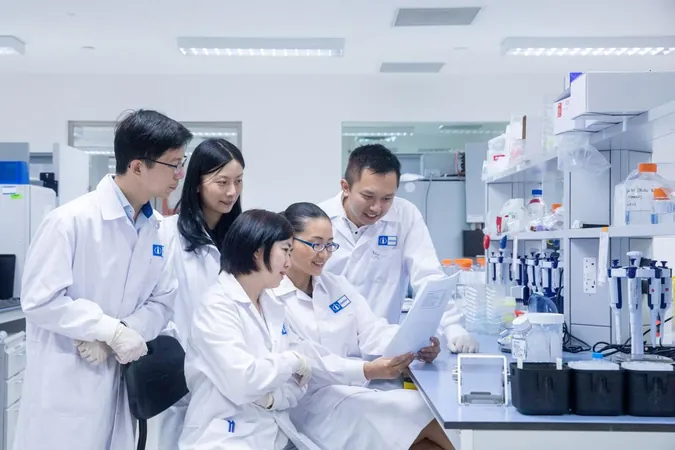
Revolutionizing Syngas Production: The Secrets of Catalytic Nanoparticles Unveiled!
2025-09-04
Author: Jia
Unlocking the Mysteries of Syngas Production
In the quest for sustainable energy solutions, the production of synthesis gas—commonly known as syngas—plays a pivotal role. Comprising a versatile mix of hydrogen (H2) and carbon monoxide (CO), syngas is essential for various industrial applications. While steam reforming has been the traditional route for its production, a more energy-efficient alternative involves generating syngas from methane (CH₄) and oxygen. However, this process requires careful management to prevent the complete combustion of methane into carbon dioxide (CO₂) and water. As a result, global research initiatives are fervently exploring new methodologies for syngas production.
The Catalytic Edge of Palladium
Catalysts like palladium hold the key to this transformation, yet the precise mechanism of how methane is converted into syngas on palladium surfaces has remained a mystery—until now. A groundbreaking collaboration between TU Wien and the National University of Singapore has ventured into uncharted territory, utilizing high-resolution transmission electron microscopy (TEM) to observe the catalytic process in real time. This innovative approach, coupled with computational simulations, has unveiled crucial insights into the synergistic interactions within catalyst regions.
Why Methane Matters for Our Future
"Methane is a crucial component of natural gas, utilized not just for heating—an activity that raises concerns regarding climate change—but also as a feedstock for chemicals and fuels," explains Prof. Günther Rupprechter from TU Wien. As the world moves toward greener alternatives, methane's role in syngas production will remain significant for the foreseeable future.
The Quest for Efficient Production
In light of methane's significance, researchers are on a relentless mission to refine the production process of syngas through the partial oxidation of methane (POM), circumventing the pitfalls of over-oxidation. Historically, many studies have focused on nickel-based catalysts. However, recent explorations into palladium nanoparticles are shedding new light on a potentially more effective alternative.
Real-Time Observation: The Breakthrough Study
While prior knowledge acknowledged the efficiency of metal nanoparticles as catalysts, a question loomed large: Is it the palladium nanoparticles creating the catalytic effects, or is it the palladium oxide formed during the reaction? To tackle this, researchers employed operando TEM to visualize the particles during the reaction while concurrently using mass spectrometry to track product formation. This comprehensive approach marked a first in delivering clarity on the underlying mechanisms driving the process.
The Winning Combination: Metal and Oxide Synergy
Through advanced simulations led by Alexander Genest and PhD candidate Parinya (Lewis) Tangpakonsab, the study revealed a surprising truth: the optimal catalytic performance results not from individual components but from the collaboration of palladium and palladium oxide. "The two phases fulfill distinct roles," Rupprechter elaborates. Palladium dehydrogenates methane into carbon and hydrogen, while palladium oxide oxidizes the carbon into CO. This catalytic dance occurs most efficiently at the interfaces between the two materials.
Pioneering Future Research in Nanoparticle Catalysis
The insights gained from this landmark study pave the way for further investigations under real-world industrial conditions. With support from the MECS Cluster of Excellence, TU Wien is set to enhance its capacity for operando-TEM studies, promising exciting advancements in the efficient production of syngas. As we stand on the brink of potentially transformative developments in energy production, the role of nanoparticle catalysis promises to hold greater significance than ever.




 Brasil (PT)
Brasil (PT)
 Canada (EN)
Canada (EN)
 Chile (ES)
Chile (ES)
 Česko (CS)
Česko (CS)
 대한민국 (KO)
대한민국 (KO)
 España (ES)
España (ES)
 France (FR)
France (FR)
 Hong Kong (EN)
Hong Kong (EN)
 Italia (IT)
Italia (IT)
 日本 (JA)
日本 (JA)
 Magyarország (HU)
Magyarország (HU)
 Norge (NO)
Norge (NO)
 Polska (PL)
Polska (PL)
 Schweiz (DE)
Schweiz (DE)
 Singapore (EN)
Singapore (EN)
 Sverige (SV)
Sverige (SV)
 Suomi (FI)
Suomi (FI)
 Türkiye (TR)
Türkiye (TR)
 الإمارات العربية المتحدة (AR)
الإمارات العربية المتحدة (AR)